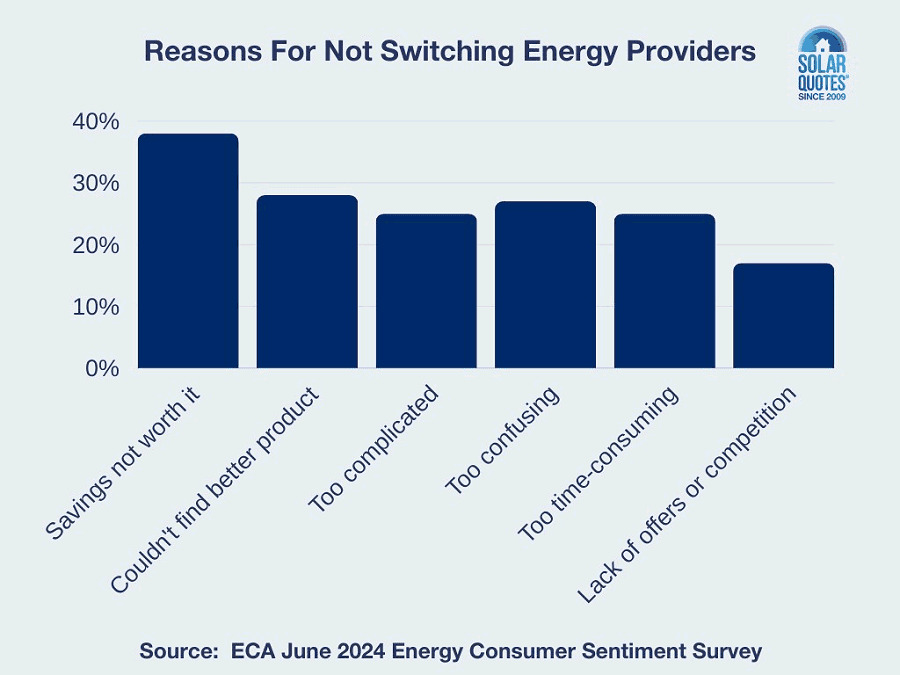
A recent survey indicates electricity and gas companies are trusted by fewer Australians than telcos, banks and supermarkets.
Energy Consumers Australia’s (ECA’s) latest Sentiment Survey canvassed more than 2,100 households and 500 small business owners across Australia.
55% of residential electricity and 59% of gas customers said their retailer provided good value for money, which represented decreases on June 2023. In terms of trust, only 43% of respondents trusted power companies to do the right thing by their customers and by Australia as a whole. Trust in gas companies was a little less at 42%.
It’s really not surprising given the antics of some retailers, such as unexpected changes to a household’s electricity tariffs after a smart meter is installed – including whacking some with demand tariffs. The behaviour has recently triggered the Australian Energy Market Commission (AEMC) to commit to carry out a broad electricity tariff pricing review.
There’s been a lot of attention focused on supermarkets and a related ACCC inquiry to examine their pricing practices. Energy Consumers Australia CEO Brendan French points out:
“If consumers rate energy services as worse value for money and energy companies as less trustworthy than supermarkets then that’s a clear sign the sector is failing consumers. We need better consumer protections and tighter enforcement of retailer behaviour.”
Switching Energy Retailers – Or Not?
With dissatisfaction so prevalent, are Australian households bothering to compare electricity plans and/or gas offers and taking further action in droves? Among survey respondents, in the past year:
- 9% changed their energy company.
- 10% switched to a better offer from their current energy company.
- 26% considered changing energy retailer or switching to a better offer with their current provider, but decided not to.
- 55% didn’t consider it, or didn’t bother investigating.
When consumers were asked to think back to the last time they considered an energy retailer switch (whenever that was) but ultimately didn’t, the reasons:
- 38% said the savings weren’t worth it.
- 28% couldn’t find a better product for their circumstances.
- 25% said it was too complicated.
- 27% said it was too confusing
- 25% indicated it was too time-consuming.
- 17% cited a lack of offers or competition.
Getting Real Support To Households Needing It Most
While the federal and some state governments are offering electricity rebates to help with the cost-of-living crisis, these are a band-aid solution if energy prices remain elevated.
Strategies such as installing a solar power system can knock a mighty dent in power bills, and the national solar panel rebate (along with incentives offered in some states) can take thousands off the up-front cost of a system. But there’s still an initial and significant outlay when buying outright. Many low- income households – and increasingly higher income households too – risk remaining trapped by high energy bills. Among these households are renters, who need special considerations as they are often at an even greater disadvantage.
The survey found that aside from the highest income bracket, more than half of households say they are either under financial pressure or managing to afford household bills but struggling to afford anything extra.
“It is therefore unlikely most are able to afford major energy upgrades such as energy efficiency improvements or Consumer Energy Resources,” states Energy Consumers Australia.
ECA wants to see Australians on low incomes and those under financial pressure provided with enough financial support to be able to access the savings to be had through energy efficiency upgrades and items such as solar power systems.
On a related note, there are various finance options for solar, but care needs to be taken. Approached wisely, a suitably-sized solar power system acquired this way can save more money every month than it costs to finance.
More topline results and commentary from the June 2024 Energy Consumer Sentiment Survey report can be accessed here.


 RSS - Posts
RSS - Posts



I don’t think it’s just retailers that people don’t trust, the whole system seems to be geared more towards profit than a beneficial outcome for the consumer.
Does that system include federal and state government’s assorted interventions and interference in the energy sector?
A new article out says QLD Labor are facing a wipeout.
Not sure what that means for energy policy though. A quick Duck and a look around the LNP website doesn’t show much, a couple of news articles about Labor being the main relevant bit – Callide C still not back up and running 973 days and multiple deadlines after the original explosion, and Paradise Dam still a mess 4 years after the infrastructure failure was identified, though that latter’s water and not hydro, I think?
Given LNP are supposed to prefer coal to solar, let alone wind or battery, maybe there’ll be changes coming? Unless of course they prefer clean green nuclear energy? ; – P
It’s almost like electricity/energy supply should be a public utility service, and not run by corporations that are attempting to make money…
Matt, some of the transmission and distribution companies in Australia are state owned corporations – Tasmania’s TasNetworks, or Queensland’s Energex and Ergon Energy.
Then you have the likes of Ausgrid in NSW which is 50.4% owned by AustralianSuper and IFM Investors – both Melbourne based, with the NSW government a minority shareholder. Alternatively you have SA Power Networks which is 51% owned by Cheung Kong Infrastructure – a Hong Kong based company, and 49% Spark Infrastructure – a Sydney based investment fund.
So some are run to make state governments profits, others to make super profits, and some make money for companies overseas. Is your idea of a public utility service a non-profit making entity?
Or do you mean generation, the powerplants themselves? The eastern states rely on coal and ownership of those is rather complicated. Obviously you have AGL, Origin, and EnergyAustralia – the big 3, but there are also a number of other state, public, and foreign corporations owning parts of the coal generating power stations.
For solar there’s a several dozen, many of which are foreign owned, and almost none are corporations known to the public. Wind is similar. If it wasn’t profitable then foreign corporations or investment entities like the Macquarie Group wouldn’t be getting in on the act!!!
Are power bills going up because of how much money can be made?
In my opinion, the whole system needs an overhaul. I think the retailers plans on their websites are deliberately made complicated to suck in the vulnerable.
As a former small Telecommunications provider, we had to supply the Customer with an easy to read and understand document, call a Critical Information Summary. (CIS).
Ours was a 1 A4 page 10 font, summary of what it cost you (inc GST), the Plan details, any extra charges and our commitments to the service we provide. Plain an simple.
We never had any disputes about our CIS.
Power retailers however seem to be exempt from simplifying things.
Just looking at my AGL rates, there is no mention of weekend rate charges, so I assume the weekend rate is the same as weekly, but I don’t know. (The old bill format mentioned the weekend rates)
From this I worked out that Off Peak is 01:00 hrs to 06:00 hrs, so why not just say that?
Controlled load At all times $0.2085
Peak 6am-10am and 3pm-1am every day $0.4905
Off peak All other times $0.3362
Shoulder 10am-3pm every day $0.2875
Supply charge Daily 31 days $0.9996
I know what Controlled Load is, but does the average person and do they know what is required to have a Controlled load and when Controlled Load actually supplies power to your home? I think not.
It’s probably in the fine print somewhere, but like any contract, who has the time or money to fund a legal explanation?
It would be interesting if somebody ran a survey to see if the average person really understood their bill.
In summary, the only reason the retailers make their websites so convoluted is to deliberately confuse people that are not that IT literate, possibly the elderly. Why doesn’t the energy ombudsman intervene?
Good points Paul,
Time of Use energy metering is only going to confuse people more than the arcane accumulation meters and block pricing of old. It’ll be made worse by demand charges.
Luckily there are some really good tools available now, like Bill Hero and Solar Analytics (from Catch Power) which use your actual meter data to find better deals than you ever can with a pencil and paper.
At the end of the day we’re going through an energy transformation where the amount of energy you use and the time you use it will matter much more than it ever has before.
The take home message really needs to be use power when it’s cheap, which is going to be daytime.